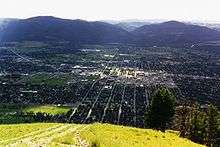Andrew B. Hammond
| Andrew B. Hammond | |
|---|---|
 | |
| Born |
Andrew Benoni Hammond July 22, 1848 Saint-Léonard, New Brunswick |
| Died |
January 15, 1934 (aged 85) San Francisco, California |
| Occupation | entrepreneur |
| Known for | Founder of the Missoula Mercantile Co. and Hammond Lumber Company |
| Spouse(s) | Florence Abbott |
Andrew Benoni Hammond (1848–1934) was an American lumberman. He developed the Missoula Mercantile Co. He built the Bitterroot Valley Railroad[1] and the Astoria & Columbia River Railroad.[2] He was president of the Hammond Lumber Co. and the Hammond Steamship Co.
Biography
Hammond was born in Saint-Léonard, New Brunswick, Canada on July 22, 1848. He left home at 16 years old to work in the logging camps of Maine and Pennsylvania. He arrived in Montana in 1867, worked as a woodcutter and store clerk, eventually becoming a partner in the mercantile firm of Bonner, Eddy and Company. Under Hammond's management this became the Missoula Mercantile Company, the largest mercantile between St. Paul and Portland.
Hammond and his partners received the contract to build the intermountain section of the Northern Pacific railway line, from Helena to Spokane. In the 1890s, Hammond moved to the West Coast and built two more railroads. In 1900, he began to assemble one of the largest lumber companies on the West Coast, including the world's largest redwood lumber company and the world's largest lumber yard in Los Angeles.
During World War I, Hammond was the largest supplier of Sitka spruce wood to the U.S. Army, which needed it to manufacture airplanes.[3]
Hammond is most known for his role in the poaching of federal timber during his years in Montana, and his anti-union efforts during the early twentieth century. Ironically, much of the Hammond Lumber Company lands that were illegally acquired under the federal Timber and Stone Act in Humboldt County eventually formed the bulk of Redwood National and State Parks.
Death and legacy
Hammond died on January 15, 1934, in San Francisco, California, at age 85.
The community of Hammond, Oregon was named for him.[4]
Footnotes
- ↑
- ↑
- ↑ "Andrew B. Hammond," by Greg Gordon
- ↑ Lewis A. McArthur and Lewis L. McArthur, Oregon Geographic Names. 7th Edition. Portland, OR: Oregon Historical Society Press, 2003; pg. 440.
Further reading
- Gordon, Greg. A.B. Hammond and Chief Charlot: Crossroads of Change in Western Montana. Missoula, MT: G. Gordon, 2007.
- Gordon, Greg. When Money Grew on Trees: A.B. Hammond and the Age of the Timber Baron. Norman, OK: University of Oklahoma Press, 2014.
- Cornwall, George M. "The Passing of a Stalwart Lumberman." Timberman, vol. 35 (January 1934), pg. 62.
- McKinney, Gage. "A. B. Hammond, West Coast Lumberman." Journal of Forest History, vol. 28 (October 1984), pp. 196–203.
- McKinney, Gage. "A Redwood Giant of the Past." Merchant, vol. 56 (March 1978), pp. 16–17, 57, 68-71.
- Mengel, Lowell S. "A. B. Hammond Built a Vast Timber Empire." Humboldt Historian, vol. 36 (November/December 1985), pp. 6–9.
- Stoddard, Bill. "Hammond in the Tillamook." Columbia River & Pacific Northwest Timberperson, vol. 2 (Winter 1983), pp. 6–9, 12-14.
- Thompson, Dennis Blake. "Hammond's 17: Surviving the Gap." Tall Timber Short Lines, vol. 80 (Fall 2005), pp. 29–33.
